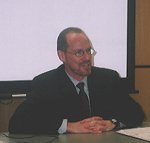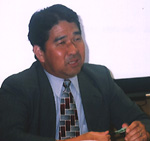Title: "Media Disclosure Practices at Japanese and U.S. Corporations"
 (1) Information Management in Japan: Inconsistent practices and "amae no kozo" (1) Information Management in Japan: Inconsistent practices and "amae no kozo"
The role of corporate communications offices in the U.S. is broadly to manage information, providing a consistent message. In many cases in Japan, however, a key function of P.R. offices is to control or limit access to executives who can provide information. The message is often inconsistent, and in extreme cases English-language press releases or P.R. officers dealing with foreign media give very different information from what is provided on the Japanese side. There also appears in many cases to be an implicit understanding -- a sort of "amae no kozo" or structure of dependence -- in which reporters are expected to use discretion in deciding what information or comments to publish in order to protect the individuals they interview.
(2) Media Institutions and Practices: Barriers to access
Some of the traditional obstacles to information for the foreign and non-mainstream Japanese media, notably the "press clubs", have declined substantially in importance for industry-related news. Some foreign media have also been allowed membership in the clubs. Other traditional Japanese practices such as "kondankai", or informal gatherings of reporters and top executives, and "yomawari", in which reporters go to executives' homes in the evening to seek comments or news tips, are also either declining in importance or opening up to a wider range of media. Still, these practices contrast with the more tightly managed conference calls and phone interviews that are a principal form of contact between the business press and corporate executives in the U.S. The dominance of one business publication, such as the Nihon Keizai Shimbun, which receives preferred access to executives and information, is not unique to Japan, although the scale of Nikkei's dominance is considerably greater than would be likely in the U.S.
 (3) Trends in Corporate Media Relations and Financial Journalism (3) Trends in Corporate Media Relations and Financial Journalism
With their increasing global exposure, Japanese companies, especially those listed on overseas stock exchanges, are closing the gap with their U.S. counterparts in terms of information management and disclosure (Recent scandals have also shown the limits of U.S. disclosure rules and practices, although those scandals are as much or more a reflection of fraudulent behaviour by executives than systemic problems). Many Japanese firms have started quarterly reporting, instead of half- and full-year reporting, even before the Tokyo Stock Exchange mandates it for all listed companies starting in the next fiscal year. The rise of the Internet is making news and information into a commodity, forcing news organisations to find new ways to add value to their stories. This is encouraging greater specialisation and globalisation by journalists and news organisations. The U.S. SEC's Regulation "FD", or "full disclosure", is also fuelling this commoditisation. The regulation prohibits companies from revealing "material information" that could affect their share price only to a select group of analysts, requiring it be disclosed to the media as well. As access to information opens up and commoditisation proceeds, greater importance will be placed on value added: how news and information is interpreted, packaged and put into context.
Title: "Recent Developments in the Internet and PR Activities"
 I spoke here a couple of months ago on Journalism in the Information Technology era. I went to New York in June to further the research on journalism. I mainly interviewed public relations professionals. It is because people within the changing world often do not realize their world is changing. So I thought PR people tend to see the change that is taking place in journalism profession more that journalists themselves. I spoke here a couple of months ago on Journalism in the Information Technology era. I went to New York in June to further the research on journalism. I mainly interviewed public relations professionals. It is because people within the changing world often do not realize their world is changing. So I thought PR people tend to see the change that is taking place in journalism profession more that journalists themselves.
Almost all the PR professionals I interviewed told me that the nature of their job had been changed drastically in last few years. One PR person told me that information used to move through a liner line from companies to the press, then to the general public. Information now, however, moves though network of the press, web, and bulletin boards, to the public. The press no longer is the only infomediary.
One PR guy used to own his own PR firm. At one time, he was managing Nikon account He wanted to find out what information the general public rely on when they make purchasing decision on cameras. One consumer told him that he purchased camera based on a friend's advise. The friend was informed by another friend. This PR guy followed the link and finally reached a web site called "Steve's digicam." The site is run by a person named Steve who is a camera fanatic. The PR guy realized that Steve's digicam is very influential, so he contacted Steve and decided to work with him. The PR guy gave Steve exclusive information on Nikon's new camera which was scheduled to be available to the public soon. When the cameras finally arrived stores, there were consumers waiting for them, and the sale went up 15% more than the previous version of the camera.
Almost all the PR firms now monitor the conversation of electronic bulletin boards. One firm uses a software called spider which automatically goes around many bulletin boards and pick up all the comments containing such key words as companys' or products' name. Then, a dozen researcher analyze the comments and turn in reports twice a week to the client companies.
Another PR firm identified 11 million influential people on the web. These influential people relay messages to 15 people on average. Therefore, if you reach these 11 influential people, you can reach 165 million people. This PR firm regard these people very important infomediary.
|





